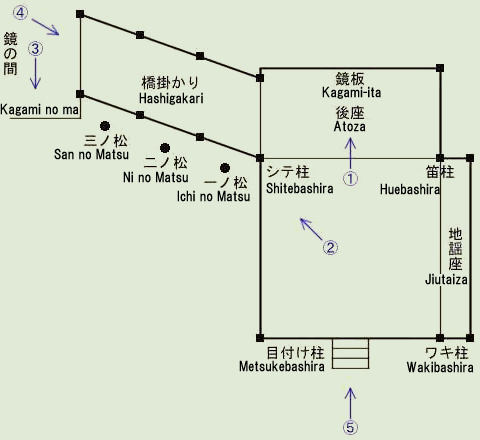

EThe
stage of gNohh
Between the Momoyama era and the Edo era, the stage of Noh was prescribed in a patterned form, and from the former open-air stage, a painting of a pine is painted in the center (KAGAMI-ITA) and it has a roof even though it is indoors.
There is a passage about three rooms away from the curtain leading to the stage, which is called HASHI-GAKARI. The main stage is about three rooms long on all sides, and there are other little stages around the main stage like JIUTAI-ZA and ATO-ZA, which forms the stage.
The main stage has pillars on all corners, and they are called SHITE-BASHIRA, METSUKE-BASHIRA, WAKI-BASHIRA, FUE-BASHIRA, and it is there to guide the performers.
Between the Momoyama era and the Edo era, the stage of Noh was prescribed in a patterned form, and from the former open-air stage, a painting of a pine is painted in the center (KAGAMI-ITA) and it has a roof even though it is indoors.
There is a passage about three rooms away from the curtain leading to the stage, which is called HASHI-GAKARI. The main stage is about three rooms long on all sides, and there are other little stages around the main stage like JIUTAI-ZA and ATO-ZA, which forms the stage.
The main stage has pillars on all corners, and they are called SHITE-BASHIRA, METSUKE-BASHIRA, WAKI-BASHIRA, FUE-BASHIRA, and it is there to guide the performers.
 |
| @KAGAMI-ITA AHASHI-GAKARI BKagami no ma CThe view from gKagami no mah to gHASHI-GAKARIh DThe view from the front |


copyright(c) UMEWAKA Yasunori.All rights
reserved.